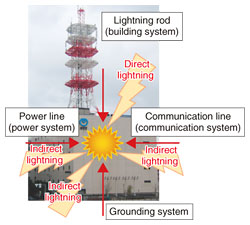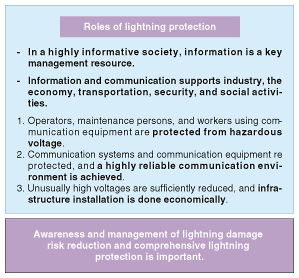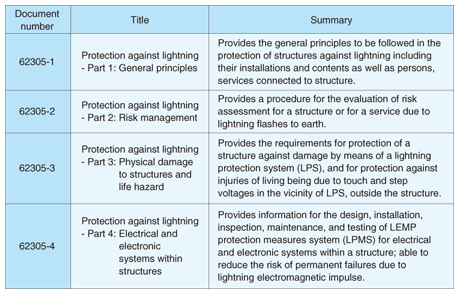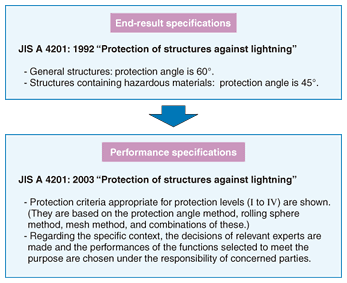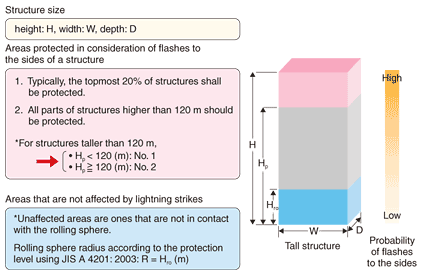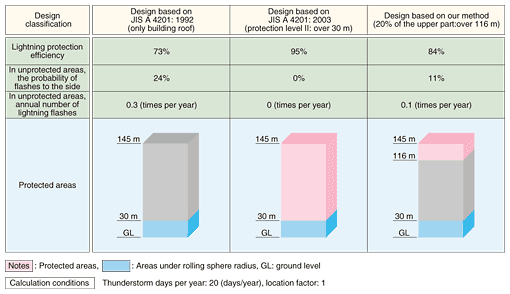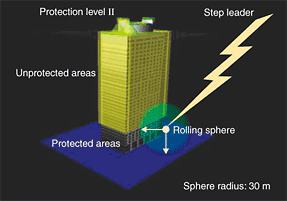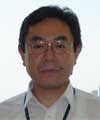 |
|||||||||||||||
|
|
|||||||||||||||
|
Special Feature: EMC Technology for IP Network Infrastructure Vol. 5, No. 12, pp. 62–68, Dec. 2007. https://doi.org/10.53829/ntr200712sf5 Design Technology for an External Lightning Protection System for a Telecommunications BuildingAbstractThis article describes technology for designing an external lightning protection system for a telecommunications building in accordance with the latest international standards for lightning protection. The design method for an air-termination system that applies lightning-strike risk assessment and an example of a design case are also described.
1. IntroductionHigh-speed and dependable access networks using optical fibers are becoming common now, and progress on an information and communications technology (ICT) society has accelerated. As the dependence on information and telecommunications increases, companies and society will face a high risk of damage from system failures, and the damage itself could be extremely severe. Therefore, the importance of high reliability for the IP (Internet protocol) network infrastructure, which supports the progress of our information society, is growing steadily. Diversification, advanced features, and complexity are being pursued to enable the IP network infrastructure to provide us with greater benefits. However, overvoltage resistance, which protects against problems such as lightning surges, is declining in today's information technology (IT) equipment, which focuses on high-speed, power-saving, and low-voltage operation. Moreover, the break-in path of lightning surges is being complicated by the diversification of networks and equipment connection configurations (Fig. 1). Therefore, the IP network infrastructure is now more vulnerable to lightning damage, and the problems caused by lightning damage have increased [1]. Consequently, the importance of lightning protection (Fig. 2) has been increasing substantially.
2. Need for risk assessmentAlthough the theory of lightning is being elucidated, complete protection against lightning damage is still difficult to achieve with present technology. Because of the importance and value of the facilities that we are dealing with and the impact on society of damage to them, we need to apply lightning protection based on risk management to reduce the potential for damage effectively and economically. The IEC 62305 series (IEC: International Electrotechnical Commission), which is a new international standard that includes risk management technology for lightning damage, was published in January 2006. The IEC comprehensively defined lightning protection and risk management for structures and infrastructure services (Table 1) [2]–[5].
IEC 62305-2, “Protection against lightning—Part 2: Risk management” classifies the parameters of risk elements for each structure and each piece of equipment and defines the calculation formula for performing risk assessment. The calculation program “Simplified Risk Assessment Calculator” is shown in Annex J. IEC 62305-3, “Protection against lightning—Part 3: Physical damage to structures and life hazards,” which defines an evaluation of the probability of the occurrence of lightning flashes to the side of a tall structure, includes (1) a regulation of the possibility of flashes to the side of a structure taller than 60 m, (2) protection of the topmost 20% of the structure, and (3) for a building higher than 120 m, protection for all parts above this level that may in danger. These regulations are more effective and economical than previous ones. Thus, more effective and economical lightning protection that applies risk assessment on a case-by-case basis, rather than uniform lightning protection, needs to be implemented. This in turn requires appropriate lightning protection standards and risk assessment design methods. 3. Design technology for external lightning protection systemsLightning protection requires a synthetic measure against the various break-in paths of lightning surges, which are shown in Fig. 1. However, the scope of this article focuses on the protection of structures against lightning. We present design technology that takes into consideration an assessment of the risk to an air-termination system, which is one element of an external lightning protection system that consists of a down-conductor system and an earth-termination system. 4. Trends in external lightning protection measuresBuildings and other structures constructed in Japan require lightning protection that is based on The Building Standard Law of Japan and The Fire Fighting Law of Japan. These technical requirements have become JIS A 4201. The 1992 version, JIS A 4201: 1992 “The protection of structures against lightning”, was extensively revised in July 2003 as JIS A 4201: 2003 “Protection of structures against lightning” (Fig. 3).
In JIS A 4201: 1992, the protection angle of the lightning rod is 60° (for sites containing hazardous materials, the angle is 45°), regardless of the height of the structure. However, JIS A 4201: 2003 provides four levels of lightning protection (I–IV) according to a structure's height and the required protection level [6]. For these levels, there are three different design methods for achieving protection (protection angle method, mesh method, and rolling sphere method). It is possible to achieve protection by selecting either one of these methods or a combination of two or all three. Moreover, each method is regulated according to the protection level. For example, when the rolling sphere method is selected, the sphere radius is specified as 20, 30, 45, or 60 m, according to the protection level. After this revision, the second clause of the supplementary provision of the “Public Notice of the Ministry of Land, Infrastructure and Transport (Japan) No. 650 of 2003” was written so as to define an external lightning protection system conforming to JIS A 4201: 1992. It was also recognized that designs conforming to JIS A 4201: 2003 also meet the requirements of the Building Standard Law of Japan. Thus, both versions of JIS A 4201 are currently still in legal use, though in practice they cannot be combined. 5. Design method of air-termination system applying lightning-strike risk assessmentIn JIS A 4201: 1992, there is no consideration of lightning protection to the sides of buildings. When JIS A 4201: 2003 was adopted as the technical requirements for the Building Standard Law of Japan, the lightning protection against flashes to building sides was based on the rolling sphere method. Although all of the sidewalls of structures taller than the rolling sphere radius are protected at each of the four protection levels, their lightning-strike risk, i.e., the occurrence probability of flashes to the sides of structures, differs according to the structure's height. Therefore, for an air-termination system, we need a design method that takes into account lightning-strike risk assessment. When JIS A 4201: 1992 was used as the basis for the Building Standard Law of Japan, it presented an economic advantage over JIS A 4201: 2003. However, the 1992 standard has a serious drawback in that it does not take into consideration flashes to sidewalls. Lightning flashes to the sides of the upper levels of structures are often reported (for example, to the Diet Building and the Tokyo Metropolitan Government Office), so JIS A 4201: 1992 is not really appropriate for lightning protection. NTT has developed and applied a design method that incorporates lightning-strike risk assessment as the design method for air-termination systems of the NTT Group. This method is based on JIS A4201: 1992 to meet the technical requirements of the Building Standard Law of Japan; in addition, it also satisfies the requirements for lightning protection systems covering protection against flashes to the sides of tall structures specified in the latest IEC62305-3 (2006). This method can provide designs that are both economical and effective in terms of lightning protection. An air-termination system design method that includes lightning-strike risk assessment protects the topmost 20% (or all the parts above 120 m that may be in danger) of tall structures. This can be achieved after evaluating the occurrence probability of flashes to the sides of structures using the rolling sphere method based on IEC 62305-3: 2006 (Fig. 4). This evaluation is a measure taken in addition to the design of an air-termination system based on the protection angle method of JIS A 4201: 1992. After the technical requirements of JIS A 4201: 1992 have been met, this method will provide an additional measure against flashes to the sides of structures, so the design will in no way violate Japanese law. JIS A 4201: 2003 also strongly recommends that all parts of the structures with a sidewall flash occurrence probability should be protected. However, an evaluation of the occurrence probability of flashes to the sides of unprotected areas showed that our design method achieves superior economic efficiency because it protects the topmost 20% (or all parts over 120 m) of tall structures in accordance with IEC 62305-3: 2006.
Our design procedure was as follows. First, the required level of lightning protection was established, and the occurrence probability of side flashes was calculated for all lightning currents having a probability of a lightning-strike exceeding the lightning current based on each of the lightning protection levels (the details are based on IEC 62305-1: 2006). Next, the occurrence probability of side flashes was evaluated for the two cases when the topmost 20% (or parts over 120 m) of tall structures was and was not protected. Then, based on the results, the lightning-strike probability and the economic efficiency were weighed for designs with the following bases: (1) JIS A 4201: 1992, (2) JIS A 4201: 2003, and (3) our method (Fig. 5). Next, after taking into consideration the requests of the building owners, the surrounding environments, and the importance of the structures, we checked the validity of our design method. Our findings showed it to be superior to the other methods. Therefore, we designed the air-termination system using our method.
6. Design exampleIn one design case, we designed improvements to an existing external lightning protection system using our design method for a structure nearly 150 m high. Based on the design decision data shown in Fig. 5, the building owner decided to use our design method after considering the probability of flashes to unprotected areas and the cost of renovating the facility. We were able to reduce the renovation costs by about one third compared with a design based on JIS A 4201: 2003. 7. Diagnostic tools for external lightning protectionVarious laws and specifications (such as those of JIS A 4201: 1992, JIS A 4201: 2003, and IEC 62305-3: 2006) must be observed in designing an air-termination system, and the system must be designed properly. Therefore, we have developed and used diagnostic tools for the external lightning protection systems of NTT Facilities. Our 3D Lightning Protection Diagnosis System applies calculation logic in accordance with JIS A 4201 (both 1992 and 2003), and it can easily indicate the areas of a structure protected by an air-termination system. JIS A 4201: 2003 provides design methods for the protection angle, rolling sphere, and mesh methods based on the structure's height and required protection level. Thus, to determine the protected area of a structure, we need a design that provides a more complex calculation and intricate operation than that provided by only the protection angle method of JIS A 4201: 1992. Using this 3D model, our diagnosis system can create a 3D model of a building to be protected and analyze the protected and unprotected areas according to the protection level required by JIS A 4201: 2003. It can then present the analysis results in a 3D visualization. As a result, it is easy to determine the protected and unprotected areas of the structure (Fig. 6).
Furthermore, we are also developing an External Lightning Protection Design Support System that includes a function for outputting a 2D engineering drawing (for the external lightning protection system) to the 3D Lightning Protection Diagnosis System. 8. ConclusionThe number of different structures is as large as the number of structures itself because each structure is a unique combination of its internal electrical systems, the function of the structure, and the building's appearance. Therefore, we need to implement lightning protection that applies lightning-strike risk assessment, not according to a uniform means of lightning protection, but on a case-by-case basis. This requires advanced research on risk management technology for lightning protection. Hopefully, relevant laws and regulations and various codes and standards will be enacted. For example, JIS A 4201 ensures consistency with the IEC 62305 series. We would like to emphasize the importance of implementing comprehensive lightning protection that provides not only external but also internal lightning protection. We are conducting research and development of surge protective devices, which are indispensable for internal lightning protection systems, as well as research and development of the external lightning protection system introduced in this article. Furthermore, we are also actively involved in standardization activities related to lightning protection in groups such as the IEC international standardization committee and the JIS draft-deliberation committee. NTT Facilities will continue to develop technology for comprehensive lightning protection that will take into consideration the latest technology trends. References
|
|||||||||||||||








